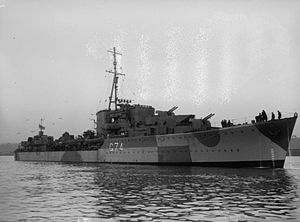HMS Legion (G74)
 HMS Legion at anchor
| |
| History | |
|---|---|
| Name | HMS Legion |
| Ordered | 31 March 1938 |
| Builder | Hawthorn Leslie and Company, Newcastle upon Tyne |
| Laid down | 1 November 1938 |
| Launched | 26 December 1939 |
| Commissioned | 19 December 1940 |
| Identification | Pennant number: G74 |
| Fate | Sunk on 26 March 1942 in air attack |
| Badge | On a Field Blue, an eagle displayed upon a perch Gold. |
| General characteristics | |
| Class and type | L-class destroyer |
| Displacement | 1,920 tons |
| Length | 362.5 ft (110.5 m) |
| Beam | 36.7 ft (11.2 m) |
| Draught | 10 ft (3.0 m) |
| Propulsion |
|
| Speed | 36 kt (66.7 km/h) |
| Range | 5,500 nmi (10,200 km) at 15 knots (28 km/h) |
| Complement | 221 |
| Armament |
|
HMS Legion was an
Construction and commissioning
Legion was ordered on 31 March 1938 from the yards of
Her commanding officer was, from commissioning until she was sunk in 1942, Captain Richard (Dick) Jessel.
Career
Home waters
On completion of repairs, Legion was assigned to the
In May she screened capital ships of the
On 22 June Legion and her sister
Malta convoys
In September she and her flotilla returned to Gibraltar and resumed escorting capital ships supplying aircraft to Malta. She provided cover on 24 September for the convoys of
The sinking of HMS Ark Royal

In November Legion was assigned to the 4th Destroyer Flotilla and escorted more convoys to Malta. On 13 November she was attacked by U-205 and carried out an unsuccessful counterattack. Meanwhile, Ark Royal was torpedoed by U-81 and disabled. Legion and her sister, Lightning stood by the stricken ship, embarking 1,560 survivors.[2] Legion later returned to Ark Royal to transfer key personnel for damage control efforts.
Action in the Mediterranean
After Ark Royal sank under tow, Legion returned to Gibraltar, arriving on 24 November. In December she was transferred to
After this success the ship was deployed with Force K, to carry out attacks on Axis convoys on passage in the central Mediterranean in support of military operations. During her service with the Force she came under air attack in an engagement on 17 December that developed into the First Battle of Sirte. She then returned to Alexandria on 19 December with Force C. When the anti-submarine boom was raised to allow the ships to enter the harbour, the Italian submarine Sciré and three human torpedoes were able to penetrate into the secure anchorage. They laid explosive charges, severely damaging the battleships Queen Elizabeth and Valiant, and the tanker Savona. On 28 December Legion and Kipling sank U-75 off Mersa Matruh after a two and half hour hunt following the sinking of the merchant vessel Volo.
Legion continued to escort convoys throughout January 1942. She was attacked on 17 January by
Further escorts of convoys followed. When one of her convoys was attacked by ships of the Italian Fleet, the Second Battle of Sirte developed, in which Legion carried out a torpedo attack. The Italians subsequently disengaged rather than risk further torpedo attacks.
Sinking and scrapping
On 23 March Legion was detached to join Eridge in escorting the merchantman Clan Campbell. During this operation, the vessels came under air attack and Legion was damaged by a near miss. The ship proceeded on one engine after successful damage control prevented her from sinking and she was beached at Malta. She was then towed to the docks on 25 March and tied up alongside the Boiler Wharf the next day. Whilst awaiting repair, the docks were the target of an air raid. Legion was hit by two bombs and sustained further serious damage when her forward magazine exploded. She rolled over and sank in the harbour, with her bridge and funnel lying on the jetty.
She was cut in two during 1943 and attempts were made to refloat her. They were unsuccessful. After the end of the war, she was broken up in situ. This was not completed until 1946.
Notes
References
- ISBN 978-1-86176-281-8.
- English, John (2001). Afridi to Nizam: British Fleet Destroyers 1937–43. Gravesend, Kent: World Ship Society. ISBN 0-905617-64-9.
- Friedman, Norman (2006). British Destroyers & Frigates: The Second World War and After. Annapolis, Maryland: Naval Institute Press. ISBN 1-86176-137-6.
- ISBN 1-55750-048-7.
- March, Edgar J. (1966). British Destroyers: A History of Development, 1892–1953; Drawn by Admiralty Permission From Official Records & Returns, Ships' Covers & Building Plans. London: Seeley Service. OCLC 164893555.
- Rohwer, Jürgen (2005). Chronology of the War at Sea 1939–1945: The Naval History of World War Two (Third Revised ed.). Annapolis, Maryland: Naval Institute Press. ISBN 1-59114-119-2.
- Smith, Peter C. (2010). Fighting Flotilla: RN Laforey Class Destroyers in WW2 (2nd ed.). Barnsley, UK: Pen & Sword Maritime. ISBN 978-1-84884-273-1.
- Whitley, M. J. (1988). Destroyers of World War 2. Annapolis, Maryland: Naval Institute Press. ISBN 0-87021-326-1.
External links
- "Allied Warships: Destroyer HMS Legion of the L class". Retrieved 9 January 2006.
- "Allied Warships: L class Destroyers". Retrieved 9 January 2006.
- "Technical Details of Ship: HMS Legion". Retrieved 9 January 2006.
- Lt Cdr Geoffrey B Mason RN (Rtd) (2002). "HMS LEGION – L-class Destroyer". Retrieved 17 December 2007.
